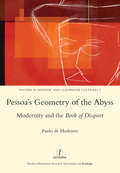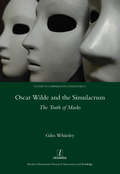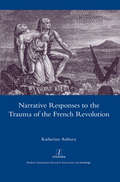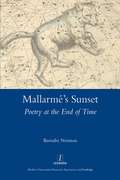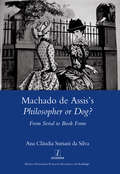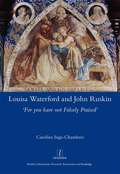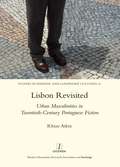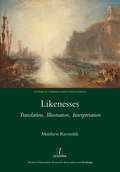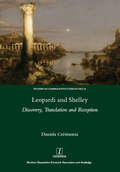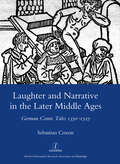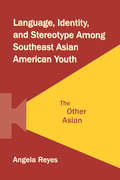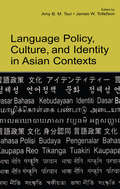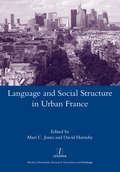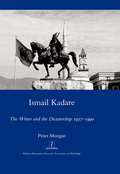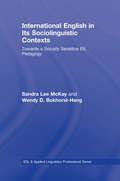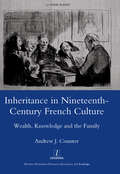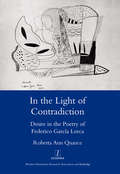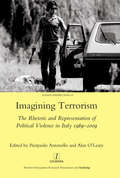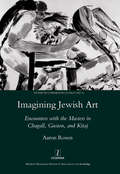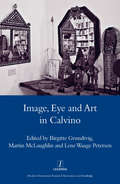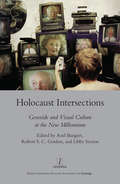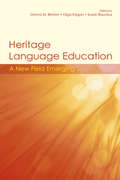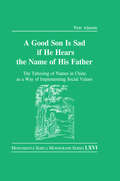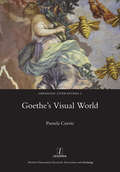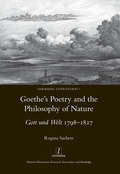- Table View
- List View
Pessoa's Geometry of the Abyss: Modernity and the Book of Disquiet
by PauloDe Medeiros"Fernando Pessoa wrote prolifically in many genres until his untimely death in 1935, and he has long been widely recognized as Portugal's most influential twentieth century writer. The publication of the Book of Disquiet in 1982, however, caused a seismic change in the appreciation of his work and its place in Modernism. In that great and vast collection of fragments, Pessoa firmly established his place among the canon of European modernists and radically questioned many of Modernity's assumptions. Alain Badiou, for example, has argued that philosophers are not yet able to assimilate Pessoa's thinking. Paulo de Medeiros's new study, one of the first to be dedicated to the Book of Disquiet, takes up that challenge, exploring the text's connections with photography, film, politics and textuality itself, and developing comparisons with D. H. Lawrence, Walter Benjamin, and Franz Kafka. Paulo de Medeiros is Professor of Modern and Contemporary World Literatures in the Department of English and Comparative Literary Studies at the University of Warwick."
Oscar Wilde and the Simulacrum: The Truth of Masks
by Giles WhiteleyOscar Wilde is more than a name, more than an author. From precocious Oxford undergraduate to cause celebre of the West End of the 1890s, to infamous criminal, the proper name Wilde has become an event in the history of literature and culture. Taking Wilde seriously as a philosopher in his own right, Whiteley's groundbreaking book places his texts into their philosophical context in order to show how Wilde broke from his peers, and in particular from idealism, and challenges recent neo-historicist readings of Wilde which seem content to limit his irruptive power. Using the paradoxical concept of the simulacrum to resituate Wilde's work in relation to both his precursors and his contemporaries, Whiteley's study reads Wilde through Deleuze and postmodern philosophical commentary on the simulacrum. In a series of striking juxtapositions, Whiteley challenges us to rethink both Oscar Wilde's aesthetics and his philosophy, to take seriously both the man and the mask. His philosophy of masks is revealed to figure a truth of a different kind - the simulacra through which Wilde begins to develop and formulate a mature philosophy that constitutes an ethics of joy.
Narrative Responses to the Trauma of the French Revolution
by Katherine AstburyDuring the French Revolution, traditional literary forms such as the sentimental novel and the moral tale dominate literary production. At first glance, it might seem that these texts are unaffected by the upheavals in France; in fact they reveal not only a surprising engagement with politics but also an internalised emotional response to the turbulence of the period. In this innovative and wide-ranging study, Katherine Astbury uses trauma theory as a way of exploring the apparent contradiction between the proliferation of non-political literary texts and the events of the Revolution. Through the narratives of established bestselling literary figures of the Ancien Regime (primarily Marmontel, Madame de Genlis and Florian), and the early works of first generation Romantics Madame de Stael and Chateaubriand, she traces how the Revolution shapes their writing, providing an intriguing new angle on cultural production of the 1790s.Katherine Astbury is Senior Lecturer in French Studies at the University of Warwick.
Mallarme's Sunset: Poetry at the End of Time
by Barnaby NormanThe writings of the great Symbolist poet Stephane Mallarme (1842-1898) were to become uniquely influential in twentieth century literary criticism. For critics and philosophers such as Maurice Blanchot and Jacques Derrida, Mallarme's name came to represent a rupture in literary history, and an opening of literature onto a radically new kind of writing. Through close readings of key works, Norman retraces Mallarme's trajectory as a poet, showing in particular how he positioned his work in relation to Hegel's Aesthetics. Analysing the motif of the sunset Norman argues that Mallarme situated his work at the conclusion of the history of art, in Hegelian terms, and it is this that made him so interesting for Blanchot and Derrida. Their readings, born of their wish to subvert Hegel's totalizing impulse, give rise to an entirely new view of works now almost universally seen as masterpieces.
Machado De Assis's Philosopher or Dog?: From Serial to Book Form
by Surianida SilvaThe great Brazilian writer Joaquim Maria Machado de Assis (1839-1908) published five of his nine novels as feuilletons in daily newspapers or fortnightly women's magazines. How were the structure and themes of those novels entangled with this serial-publication form? In da Silva's important new study, textual scholarship, critical theory and the history of the book are combined in order to trace this relationship. The most important case study is an extended consideration of Philosopher or Dog? (1891), the novel after which he abandoned the feuilleton. Through a comparison of the serial and book versions of Philosopher or Dog? and a thorough study of the periodical in which it appeared, the international women's magazine The Season , da Silva analyses the changes which the genre novel was undergoing at the end of the nineteenth century: the decline of the serial, and the standardisation of female press. Ana Claudia Suriani da Silva is Tutor of Portuguese at the University of Birmingham and Honorary Research Fellow at Birkbeck College, University of London.
Louisa Waterford and John Ruskin: 'For You Have Not Falsely Praised'
by Caroline Ings-ChambersLouisa Waterford (1818-91), modest, retiring, of good family, renowned for her beauty, and with extraordinary grace, was the embodiment of a Victorian ideal of womanhood. But like the age itself, her life was filled with contrasts and paradoxes. She had been born with artistic gifts, and became a satellite of the Pre-Raphaelite Brotherhood, though she had no formal training. Then, at the height of John Ruskin's intellectual power and success as a critic, she asked him to accept her as an art student, and he accepted. Their correspondence- often harshly critical, never, as Waterford put it, falsely praising - lies at the heart of this book. These are letters which open a spectrum of discussion on the cultural, gender and social issues of the period. Both Waterford and Ruskin engaged in tireless philanthropic work for diverse causes, crossing social boundaries with subtle determination, and both responded to a sense of duty as well as an artistic vocation. But, as Ings-Chambers shows, their correspondence was more than a dialogue about society: it helped to make Waterford the artist she became.
Lisbon Revisited: Urban Masculinities in Twentieth-Century Portuguese Fiction
by Rhian AtkinTwentieth-century Portugal saw dramatic political and social change. The monarchy was abolished, and a republic installed (1910), soon giving way to a long-lasting dictatorship (1926); a transition to democracy (1974) led to membership of the European Union (1986). But what do we know of how people lived during these periods? And how did men, in particular, respond to the changes taking place in society? In this illuminating and broad-ranging study, Rhian Atkin uses as case studies the work of Fernando Pessoa (1888-1935), Luis de Sttau Monteiro (1926-93) and Jose Saramago (1922-2010) in order to examine the relationship between socio-political change and the construction and performance of masculinities in the urban environment of Lisbon over the course of the last century.
Likenesses: Translation, Illustration, Interpretation
by Matthew ReynoldsTranslation, illustration and interpretation have at least two things in common. They all begin when sense is made in the act of reading: that is where illustrative images and explanatory words begin to form. And they all ask to be understood in relation to the works from which they have arisen: reading them is a matter of reading readings. Likenesses explores this palimpsestic realm, with examples from Dante to the contemporary sculptor Rachel Whiteread. The complexities that emerge are different from Empsonian ambiguity or de Man's unknowable infinity of signification: here, meaning dawns and fades as the hologrammic text is filled out and flattened by successive encounters. Since all literature and art is palimpsestic to some degree - Reynolds proposes - this style of interpretation can become a tactic for criticism in general. Critics need both to indulge and to distrust the metamorphic power of their interpreting imaginations. Likenesses follows on from the argument of Reynolds's The Poetry of Translation (2011), extending it through other translations and beyond them into a wide range of layered texts. Browning emerges as a key figure because his poems laminate languages, places, times and modes of utterance with such compelling energy. There are also substantial, innovative accounts of Dryden, Stubbs, Goya, Turner, Tennyson, Ungaretti and many more.
Leopardi and Shelley: Discovery, Translation and Reception
by Cerimonia DanielaGiacomo Leopardi (1798-1837) and Percy Bysshe Shelley (1792-1822) crossed paths during their lifetimes, and though they never met, the legacy of their work betrays a shared destiny. As prominent figures who challenged and contributed to the Romantic debate, Leopardi and Shelley hold important roles in the history of their respective national literatures, but paradoxically experienced a controversial and delayed reception outside their native lands. Cerimonia�s wide-ranging study brings together these two poets for the first time for an exploration of their afterlives, through a close reading of hitherto unstudied translations. This intriguing journey tells the story, from its origins, of the two poets� critical fortune, and examines their position in the cultural debates of the nineteenth century; in disputes regarding translation theories and practices; and shows the configuration of their identities as we understand their legacy today.
Laughter and Narrative in the Later Middle Ages: German Comic Tales C.1350-1525
by Sebastian CoxonIn contrast to the vernacular literary traditions of France, Italy and England, comic tales in verse flourished in late medieval Germany, providing bawdy entertainment for larger audiences of public recitals as well as for smaller numbers of individual readers. In a sustained close analysis Sebastian Coxon explores both the narrative design and fundamental thematic preoccupations of these short texts. A distinctively performative tradition of pre-modern narrative literature emerges which invited its recipients to think, learn and above all to laugh in a number of different ways.
Language, Identity, and Stereotype Among Southeast Asian American Youth: The Other Asian
by Angela ReyesThis book—an ethnographic and discourse analytic study of an after-school video-making project for 1.5- and second-generation Southeast Asian American teenagers—explores the relationships among stereotype, identity, and ethnicity that emerge in this informal educational setting. Working from a unique theoretical foundation that combines linguistic anthropology, Asian American studies, and education, and using rigorous linguistic anthropological tools to closely examine video- and audio- recorded interactions gathered during the video-making project (in which teen participants learned the skills for creating their own video and adult staff learned to respect and value the local knowledge of youth), the author builds a compelling link between micro-level uses of language and macro-level discourses of identity, race, ethnicity, and culture. In this study of the ways in which teens draw on and play with circulating stereotypes of the self and the other, Reyes uniquely illustrates how individuals can reappropriate stereotypes of their ethnic group as a resource to position themselves and others in interactionally meaningful ways, to accomplish new social actions, and to assign new meanings to stereotypes. This is an important book for academics and students in sociolinguistics, linguistic anthropology, discourse analysis, and applied linguistics with an interest in issues of youth, race, and ethnicity, and/or educational settings, and will also be of interest to readers in the fields of education, Asian American studies, social psychology, and sociology.
Language Policy, Culture, and Identity in Asian Contexts
by Amy B. M. TsuiBringing together scholarship on issues relating to language, culture, and identity, with a special focus on Asian countries, this volume makes an important contribution in terms of analyzing and demonstrating how language is closely linked with crucial social, political, and economic forces, particularly the tensions between the demands of globalization and local identity. A particular feature is the inclusion of countries that have been under-represented in the research literature, such as Nepal, Bangladesh, Brunei Darussalam, Pakistan, Cambodia, Vietnam, and Korea. The book is organized in three sections: Globalization and its Impact on Language Policies, Culture, and Identity Language Policy and the Social (Re)construction of National Cultural Identity Language Policy and Language Politics: The Role of English. Unique in its attention to how the domination of English is being addressed in relation to cultural values and identity by non-English speaking countries in a range of sociopolitical contexts, this volume will help readers to understand the impact of globalization on non-English speaking countries, particularly developing countries, which differ significantly from contexts in the West in their cultural orientations and the way identities are being constructed. Language Policy, Culture, and Identity in Asian Contexts will interest scholars and research students in the areas of language policy, education, sociolinguistics, applied linguistics, and critical linguistics. It can be adopted in graduate and advanced undergraduate courses on language policy, language in society, and language education.
Language and Social Structure in Urban France
by David HornsbyThe coming together of linguistics and sociology in the 1960's, most notably via the work of William Labov, marked a revolution in the study of language and provided a paradigm for the understanding of variation and change. Labovian quantitative methods have been employed successfully in North America, the UK, Scandinavia and New Zealand, but have had surprisingly little resonance in France, a country which poses many challenges to orthodox sociolinguistic thinking. Why, for example, does a nation with unexceptional scores on income distribution and social mobility show an exceptionally high degree of linguistic levelling, that is, the elimination of marked regional or local speech forms? And why does French appear to abound in 'hyperstyle' variables, which show greater variation on the stylistic than on the social dimension, in defiance of a well-established theory than such variables should not occur? This volume brings together leading variationist sociolinguists and sociologists from both sides of the Channel to ask: what makes France'exceptional'? In addressing this question, variationists have been forced to reassess the accepted interdisciplinary consensus, and to ask, as sociolinguistics has come of age, whether concepts and definitions have been transposed in a way which meaningfully preserves their original sense and, crucially, takes account of recent developments in sociology. Sociologists, for their part, have focused on the largely neglected area of language variation and its implications for social theory. Their findings therefore transcend the case study of a particularly enigmatic country to raise important theoretical questions for both disciplines.
Ismail Kadare: The Writer and the Dictatorship 1957-1990
by Peter MorganIsmail Kadare has experienced a life of controversy. In his own country and internationally he has been both acclaimed as a writer and condemned as a lackey of the Albanian socialist dictatorship. Coming of age after occupation and war, Kadare (b. 1936) belonged to the first generation of new Albanians. In a land where writers were routinely imprisoned, Kadare produced the most brilliant and subversive works to emerge from socialist Eastern Europe. His work brings to an end the century whose literary beginnings were marked by the terror to which Kafka gave his name. The inaugural award of the International Man-Booker Prize for Literature in 2005 marked an important milestone in the global recognition of Kadare. Ironic, multi-layered and imaginative, Kadare's writing is profoundly opposed to ideology. Through critical analysis of a representative selection of Kadare's works, Peter Morgan explains for a wide audience how Kadare survived and wrote in the repressive Albanian Stalinist environment. Peter Morgan is Professor of European Studies at the University of Western Australia.
International English in Its Sociolinguistic Contexts: Towards a Socially Sensitive EIL Pedagogy (ESL & Applied Linguistics Professional Series)
by Sandra Lee McKay Wendy D. Bokhorst-HengPresent-day globalization, migration, and the spread of English have resulted in a great diversity of social and educational contexts in which English learning is taking place. A basic assumption of this book is that because English is an international language, effective pedagogical decisions cannot be made without giving special attention to the many varied contexts in which English is taught and learned. Its unique value is the combination of three strands – globalization, sociolinguistics, and English as an international language – in one focused volume specifically designed for language teachers, providing explicit links between sociolinguistic concepts and language pedagogy. International English in Its Sociolinguistic Contexts: fully recognizes the relationship between social context and language teaching describes the social and sociolinguistic factors that affect the teaching and learning of English examines how the social context is influential in determining which languages are promoted in schools and society and how these languages are taught is unique in directly relating basic constructs in sociolinguistics to English language teaching features case studies that illustrate the diversity of English teaching contexts Directed to a wide TESOL and applied linguistics professional readership, this text will be particularly useful and effective for pre-service and in-service professional development in TESOL for K-12 and higher education levels.
Inheritance in Nineteenth-century French Culture: Wealth, Knowledge and the Family
by AndrewJ. CounterThe transmission of wealth between generations was not only a narrative commonplace in nineteenth-century France, but also a topic of considerable cultural anxiety and intense political debate. In this study, Andrew J. Counter draws on a wealth of previously unexplored material to show how the theme of inheritance in literature and beyond acquired ethical, historical and ideological connotations, and was vital to nineteenth-century French conceptions of the family and of the legacy of the Revolution. Weaving together fiction, drama, legal texts, historiographical thought and political writing, Inheritance in Nineteenth-Century French Culture teases out a complex leitmotiv that gives us a new understanding of nineteenth- century Frances sense of its own place in history. It also proposes innovative readings of writers as familiar as Honore de Balzac, George Sand, Guy de Maupassant and Emile Zola, while drawing attention to a range of neglected authors and works.
In the Light of Contradiction: Desire in the Poetry of Federico Garcia Lorca
by RobertaAnn QuanceIn 1926, as a young man of 28 with a growing reputation as an oral poet, Federico Garcia Lorca (1898-1936) toyed with the idea of proving his worth in writing by bringing out a boxed set of three volumes of his verse. Because the Suites , Canciones , and the Poema del cante jondo eventually came out singly (in the case of the Suites , posthumously), readers have not always realised that they formed a single body of work -- one which, Lorca himself was surprised to note, has 'una rarisima unidad', an odd unity of aims and accomplishment. This is poetry which takes up the question of desire in progressively depersonalizing ways, and shows modernism coming into being. Through renunciation, by cutting away the personal and the taboo, Lorca created a poetry that, like no other in Europe, stood between the avant-garde and oral traditions, making their contradictions his truth. Roberta Ann Quance is Senior Lecturer in Spanish at Queen's University, Belfast.
Imagining Terrorism: The Rhetoric and Representation of Political Violence in Italy 1969-2009
by Pierpaolo AntonelloNo other European country experienced the disruption of political and everyday life suffered by Italy in the so-called 'years of lead' (1969-c.1983), when there were more than 12,000 incidents of terrorist violence. This experience affected all aspects of Italian cultural life, shaping political, judicial and everyday language as well as artistic representation of every kind. In this innovative and broad-ranging study, experts from the fields of philosophy, history, media, law, cinema, theatre and literary studies trace how the experience and legacies of terrorism have determined the form and content of Italian cultural production and shaped the country's way of thinking about such events?
Imagining Jewish Art: Encounters with the Masters in Chagall, Guston, and Kitaj
by Aaron RosenShort-listed for the Art and Christian Enquiry/Mercers' International Book Award 2009: 'a book which makes an outstanding contribution to the dialogue between religious faith and the visual arts'. What does modern Jewish art look like? Where many scholars, critics, and curators have gone searching for the essence of Jewish art in Biblical illustrations and other traditional subjects, Rosen sets out to discover Jewishness in unlikely places. How, he asks, have modern Jewish painters explored their Jewish identity using an artistic past which is- by and large - non-Jewish? In this new book we encounter some of the great works of Western art history through Jewish eyes. We see Matthias Grunewald's Isenheim Altarpiece re-imagined by Marc Chagall (1887-1985), traces of Paolo Uccello and Piero della Francesca in Philip Guston (1913-1980), and images by Diego Velazquez and Paul Cezanne studiously reworked by R.B. Kitaj (1932-2007). This highly comparative study draws on theological, philosophical and literary sources from Franz Rosenzweig to Franz Kafka and Philip Roth. Rosen deepens our understanding not only of Chagall, Guston, and Kitaj but also of how art might serve as a key resource for rethinking such fundamental Jewish concepts as family, tradition, and homeland.
Image, Eye and Art in Calvino
by Birgitte GrundtvigFew recent writers have been as interested in the cross-over between texts and visual art as Italo Calvino (1923-85). Involved for most of his life in the publishing industry, he took as much interest in the visual as in the textual aspects of his own and other writers' books. In this volume twenty international Calvino experts, including Barenghi, Battistini, Belpoliti, Hofstadter, Ricci, Scarpa and others, consider the many facets of the interplay between the visual and textual in Calvinos works, from the use of colours in his fiction to the influence of cartoons, from the graphic qualities of the book covers themselves to the significance of photography and landscape in his fiction and non-fiction. The volume is appropriately illustrated with images evoked by Calvino's major texts.
Holocaust Intersections: Genocide and Visual Culture at the New Millennium
by Axel BangertRecent representations of the Holocaust have increasingly required us to think beyond rigid demarcations of nation and history, medium and genre. Holocaust Intersections sets out to investigate the many points of conjunction between these categories in recent images of genocide. The book examines transnational constellations in Holocaust cinema and television in Europe, disclosing instances of border-crossing and boundary-troubling at levels of production, distribution and reception. It highlights intersections between film genres, through intertextuality and pastiche, and the deployment of audiovisual Holocaust memory and testimony. Finally, the volume addresses connections between the Holocaust and other histories of genocide in the visual culture of the new millennium, engaging with the questions of transhistoricity and intercultural perspective. Drawing on a wide variety of different media - from cinema and television to installation art and the internet - and on the most recent scholarship on responses to the Holocaust, the volume aims to update our understanding of how visual culture looks at the Holocaust and genocide today. With the contributions: Robert S. C. Gordon, Axel Bangert, Libby Saxton- Introduction Emiliano Perra- Between National and Cosmopolitan: 21st Century Holocaust Television in Britain, France and Italy Judith Keilbach- Title to be announced Laura Rascaroli- Transits: Thinking at the Junctures of Images in Harun Farocki's Respite and Arnaud des Pallieres's Drancy Avenir Maxim Silverman- Haneke and the Camps Barry Langford- Globalising the Holocaust: Fantasies of Annihilation in Contemporary Media Culture Ferzina Banaji- The Nazi Killin' Business: A Post-Modern Pastiche of the Holocaust Matilda Mroz- Neighbours: Polish-Jewish Relations in Contemporary Polish Visual Culture Berber Hagedoorn- Holocaust Representation in the Multi-Platform TV Documentaries De Oorlog (The War) and 13 in de Oorlog (13 in the War) Annette Hamilton- Cambodian Genocide: Ethics and Aesthetics in the Cinema of Rithy Panh Piotr Cieplak, Emma Wilson- The Afterlife of Images
Heritage Language Education: A New Field Emerging (Routledge Handbooks In Linguistics Ser.)
by Donna M. Brinton Olga Kagan Susan Bauckus"… focuses on issues at the forefront of heritage language teaching and research. Its state-of-the-art presentation will make this volume a standard reference book for investigators, teachers, and students. It will also generate further research and discussion, thereby advancing the field." María Carreira, California State University – Long Beach, United States "In our multilingual and multicultural society there is an undeniable need to address issues of bilingualism, language maintenance, literacy development, and language policy. The subject of this book is timely…. It has potential to make a truly significant contribution to the field." María Cecilia Colombi, University of California – Davis, United States This volume presents a multidisciplinary perspective on teaching heritage language learners. Contributors from theoretical and applied linguistics, sociolinguistics, psychology, educational policy, and pedagogy specialists explore policy and societal issues, present linguistic case studies, and discuss curricular issues, offering both research and hands-on innovation. - The term "heritage language speaker" refers to an individual exposed to a language spoken at home but who is educated primarily in English. Research and curriculum design in heritage language education is just beginning. Heritage language pedagogy, including research associated with the attrition, maintenance, and growth of heritage language proficiency, is rapidly becoming a field in its own right within foreign language education. This book fills a current gap in both theory and pedagogy in this emerging field. It is a significant contribution to the goals of formulating theory, developing informed classroom practices, and creating enlightened programs for students who bring home-language knowledge into the classroom. Heritage Language Education: A New Field Emerging is dedicated to Professor Russell Campbell (1927-2003), who was instrumental in advocating for the creation of the field of heritage language education.
Good Son is Sad If He Hears the Name of His Father: The Tabooing of Names in China as a Way of Implementing Social Values (Monumenta Serica Monograph Ser.)
by Piotr AdamekWhen in 1775 the scholar Wang Xihou compiled a dictionary called Ziguan , he wrote, for illustrative purposes, the personal names of Confucius and the three emperors Kangxi, Yongzheng and Qianlong in the introduction. In oversight, he recorded their complete names. This accidental writing of a few names was condemned by Emperor Qianlong as an unprecedented crime, rebellion and high treason. Wang Xihou was executed, his property confiscated and his books were burnt. His family was arrested and his sons and grandsons were killed or sent as slaves to Heilongjiang. It is surprising what an enormous impact the tabooing of names (bihui ) had on Chinese culture. The names of sovereigns, ancestors, officials, teachers, and even friends were all considered taboo, in other words it was prohibited to pronounce them or to record them in writing. In numerous cases characters identical or similar in writing or pronunciation were often avoided as well. The tabooing of names was observed in the family and on the street, in the office and in the emperor's palace. The practice of bihui had serious consequences for the daily lives of the Chinese and for Chinese historiography. People even avoided certain places and things, and refused to accept offices. They were punished and sometimes even killed in connection with the tabooing of names. The bihui custom existed as an important element of Chinese culture and was perceived as significant by Chinese and foreigners alike. It was crucial for implementing social values and demonstrating the political hierarchy. The present work A Good Son Is Sad if He Hears the Name of His Father is a systematic study of Chinese name-tabooing customs, which until now have been relatively little explored in Western-language Sinological studies. It attempts to provide a long-term perspective on the changing dynamics of tabooing and elucidates various aspects related to the fascinating topic of tabooing of names.
Goethe's Visual World
by Pamela CurrieGoethe's ideas on colour and imagery crossed many borderlines: those of artistic processes and philosophical aesthetics, art history and colour theory, together with the science of perception. This investigation into his writings ranges across art from Antiquity, the Renaissance and the eighteenth century, as well as exploring the centrality of these issues to Goethe's literary work. Questions find answers, but also raise new questions. This systematic sequence of essays, originally written between 1999 and 2011, appeals to readers in all these separate areas, while drawing together their essential coherence.
Goethe's Poetry and the Philosophy of Nature: Gott Und Welt 1798-1827
by Regina SachersAt the beginning of the nineteenth century, philosophy and theology come under increasing pressure owing to the emergence of the modern sciences. The collection Gott und Welt is Goethe's poetic contribution to this conflict, in which an alternative to orthodox Christianity was being sought. Following the collection's various stages of composition and publication, this study offers new readings of some of Goethe's best known poems: 'Die Metamorphose der Pflanzen', 'Dauer im Wechsel', 'Urworte. Orphisch' and 'Wiederfinden'. Sachers shows that Gott und Welt is the long poem on nature which Goethe attempted to write for the last third of his life. As such it represents Goethe's unique answers to the intellectual challenges posed by the dawning age of science. Regina Sachers is Lecturer in German at Exeter College, Oxford.
